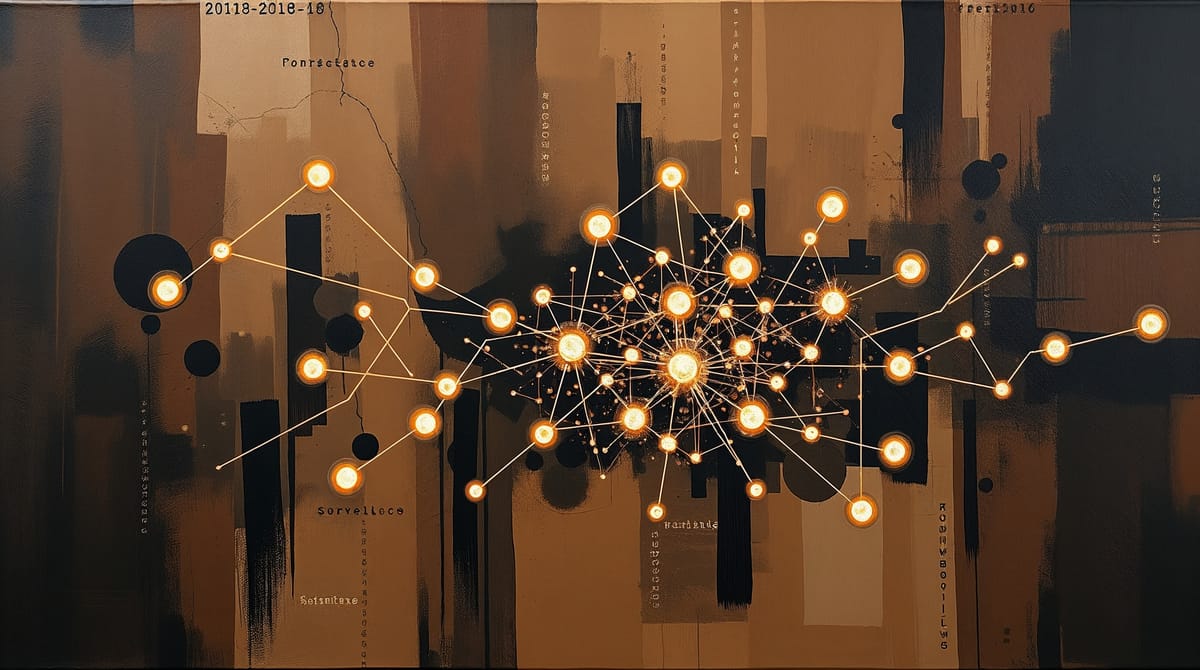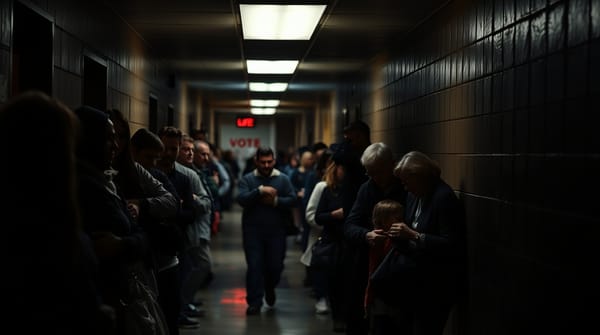Tactical Implications -- Part 3
The question now: how do you organize when organizing itself is the trap? Every encrypted message sent, every security protocol implemented, every coordination method employed by current resistance networks generates metadata that improves surveillance accuracy.

Two weeks ago, I documented how surveillance systems turn resistance activities into training data. Last week, I analyzed why traditional security measures now generate algorithmic signatures that enable predictive suppression.
The question now: how do you organize when organizing itself is the trap?
Portland's seventeen arrests weren't isolated failures—they proved that behavioral prediction systems work exactly as designed.
Every encrypted message sent, every security protocol implemented, every coordination method employed by current resistance networks generates metadata that improves surveillance accuracy.
The timeline is brutal: RakeTech's internal projections show their algorithms reaching 95% accuracy by late 2027. At that threshold, traditional resistance organizing becomes impossible.
Every conventional security measure you implement today trains the systems hunting you tomorrow. Networks that don't adapt face systematic elimination through their own tactics.
The choice is simple: evolve or be destroyed.
Tactical Implications--Adapting to Algorithmic Oppression
Every conventional resistance tactic feeds the surveillance systems designed to destroy resistance networks. Adaptation isn't optional—it's survival.
Your security tools are the trap. VPNs create traffic patterns. Encrypted messaging shows coordination timing. Burner phones link purchases. Every security measure makes you more visible.
The solution: protect coordination patterns, not just communication content. Traditional security prevents information interception. You need to prevent pattern recognition.
Practical changes:
- Eliminate regular meeting schedules,
- Eliminate predictable communication windows,
- Eliminate coordinated online activity.
- Replace secure channels with random noise generation.
- Act random instead of coordinated
Analog methods have problems, too. Ham radio creates location signatures. Bulletin boards require regular visits. Face-to-face meetings generate movement data.
Solution: Use digital channels for fake information and analog channels for real coordination. Create fake online personas. Generate noise to overwhelm their systems.
Traditional cells don't work. Hierarchical networks create patterns. Flat networks communicate too much. Use overlapping trust circles where people don't know they're part of the same network.
Bury real signals in fake noise. Create identical fake digital footprints. Send coordinated false communications. Break security protocols deliberately with fake personas to teach their systems wrong patterns.
Don't organize in the same neighborhoods—traditional networks create heat map signatures.
Counter-strategy: Look like you're loosening security when you're actually tightening it. Talk openly about digital tactics while using analog methods for real coordination.
Local networks built on personal relationships resist detection better than sophisticated technical systems. When people verify trust through mutual aid—helping with groceries, childcare, emergency repairs—they don't need digital communication.
Neighborhoods organizing around immediate community needs generates patterns that look organic.
The goal isn't perfect security. It's algorithmic invisibility—appearing chaotic to computers while remaining coordinated to humans. Stop believing encryption and VPNs will save you.
Assume everything is monitored. This isn't paranoia when surveillance systems are designed to predict and neutralize organized resistance.
The Economic Dimension--Surveillance as Profit Center
The most disturbing aspect of modern surveillance isn't its technical sophistication—it's its profitability. Resistance monitoring has become a growth industry.
RakeTech's business model transforms political dissent into recurring revenue streams. Their "Civic Harmony" division generates $847 million a year. Each resistance network they identify creates billable consulting hours. Every failed operation proves their system's value.
The individual cost is immediate and measurable. Portland network member Diana Kowalski lost her teaching position three months after the arrests—not through criminal conviction, but when her school district's 'enhanced background screening' flagged her for 'association with domestic extremist activity.'
Michael Rodriguez was denied a mortgage refinancing when algorithmic credit analysis incorporated his 'civic disruption risk score' based on social media activity and location data.
Jennifer Park's health insurance premiums increased 23% after RakeTech's wellness algorithms classified her as 'high-risk' due to protest attendance patterns tracked through her phone's location services. None of these individuals were charged with crimes. Their economic punishment preceded the legal process.
The economic incentives are perverse but logical. Traditional law enforcement costs governments money—agents, equipment, investigations, prosecutions. Algorithmic surveillance generates profit while achieving superior results. Government pays private contractors to monitor citizens who then become data sources for improved monitoring systems sold to other governments.
Resistance activities generate data that improve surveillance products, justifying higher government spending that enables more sophisticated monitoring. Each cycle increases corporate profits and state control.
RakeTech exports "American-tested" surveillance systems worldwide. Hungary uses algorithms trained on American resistance data. Turkey incorporates pattern recognition developed from Black Lives Matter analysis. China integrates behavioral prediction models proven effective against domestic organizers.
American resistance movements unwillingly provide product development for global authoritarian expansion.
Behavioral prediction data enables targeted advertising, insurance discrimination, employment screening, and credit scoring. Political activity becomes economic liability tracked across all aspects of life.
Resistance participation affects mortgage rates, job prospects, and healthcare access.
Market mechanisms achieve what direct repression cannot—gradual economic strangulation through accumulated micro-penalties.
Surveillance expansion is economically inevitable. Corporate stakeholders demand revenue growth, making resistance monitoring too profitable to abandon.
This represents capitalism's ultimate evolution: turning rebellion into a product that funds its suppression.
Strategic Assessment
Everything we thought we knew about resistance is wrong. The security measures that once provided safety now generate targeting data.
This isn't a temporary disruption—it's a permanent strategic realignment. Resistance movements must change fundamentally or face systematic destruction.
Can democratic opposition survive algorithmic prediction systems designed to neutralize organized dissent before it achieves critical mass?
Surveillance systems have limitations. They recognize patterns but struggle with unpredictable behavior. They predict based on historical patterns but fail against unprecedented approaches.
They can predict our current tactics because our tactics taught them everything. But they cannot predict what has never existed before.
Conclusion
The window for tactical adaptation is closing rapidly. RakeTech's 95% accuracy threshold represents the mathematical elimination of traditional resistance organizing. Networks have months, not years, to implement behavioral operational security before algorithmic prediction makes coordination functionally impossible.
Immediate actions for current resistance networks:
Get the Analog Resistance Toolkit
Start generating false digital patterns today.
- Create multiple online personas engaging in different political activities.
- Use encrypted channels only for misdirection.
- Build trust through mutual aid rather than digital verification.
Most critically: stop using current tactics that train surveillance systems. Every day spent implementing conventional security measures provides targeting data for systems designed to predict and neutralize your activities.
This isn't theoretical analysis—it's operational intelligence for networks facing elimination. Every resistance operation is currently choosing between evolution and destruction.
They cannot predict what has never existed before. That's the only advantage we have left.
—A. Parker,
Still here. Still documenting. Still adapting. Feed the birds.
[Comments disabled]
Important Notice
The American Autocracy Universe is a work of fiction created for educational and entertainment purposes. All organizations, characters, policies, and events described are entirely fictional and do not represent any real government agency, political organization, or individuals.
Any resemblance to actual government documents, policy proposals, or political strategies is purely coincidental and intended to illustrate historical patterns of authoritarian governance for educational purposes.
This content is protected speech under the First Amendment and is not intended to promote, encourage, or provide instruction for any illegal activities.
About the Creator
Greg Wolford is the creator of The American Autocracy Universe. This multimedia storytelling project spans blogs, podcasts, newsletters, and fiction to explore themes of resistance, documentation, and hope in the face of systematic oppression.
© 2025 Greg Wolford. Truth survives.
"Democracy dies in darkness. But it also dies in plain sight, when people stop paying attention."




